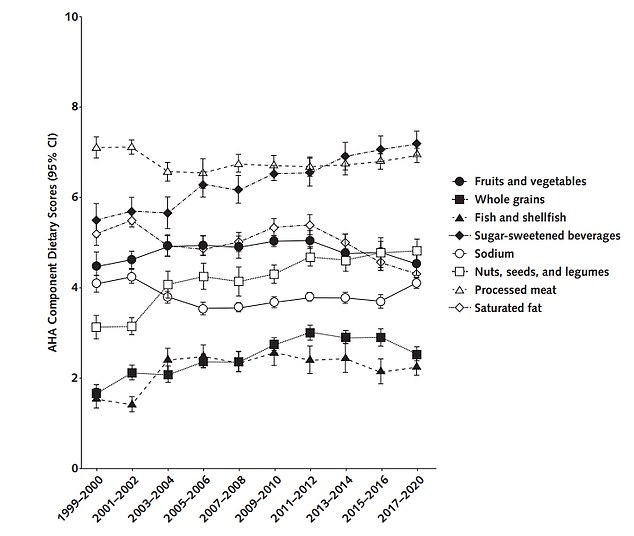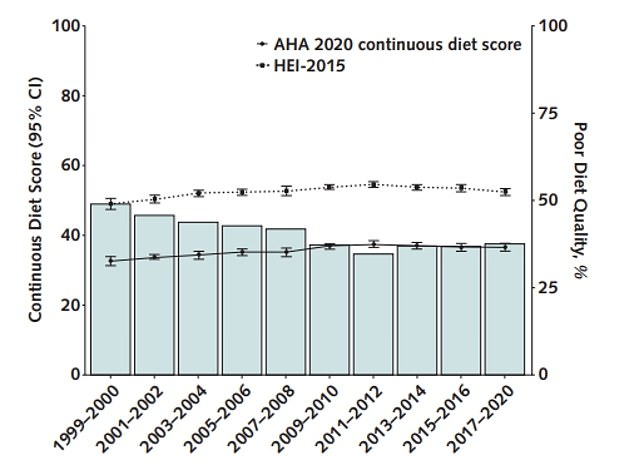Intriguing new data suggests that many more Americans are eating a healthy diet than two decades ago, casting doubt on previous studies that suggest our daily menus are worse than ever.
Researchers at Tufts University in Massachusetts analyzed the diets of 51,700 Americans ages 20 and older who responded to the National Health and Nutrition Examination Survey (NHANES) between 1999 and 2020.
They assigned “diet scores” to people based on how closely they followed the American Heart Association diet, which recommends a wide variety of fruits and vegetables, whole grains, plant proteins, fish, and minimal sugar and alcohol. .
Poor diet was defined as less than 40 percent compliance with AHA guidelines. During the study period, the proportion of adults with a poor diet decreased from 49 percent to 37 percent.
However, researchers said the percentage of people with a poor diet remains too high, contributing to the obesity epidemic in the United States.
High-fat diets are known to increase the risk of obesity, heart disease and type 2 diabetes.
While rates of body mass index increase appear to be slowing, more Americans than ever are now classified as severely obese, Statistical news reported.
The study’s lead author, Dr. Dariush Mozaffarian, a cardiologist and director of the Food is Medicine Institute, said: “Although we have seen some modest improvements in American diets over the past two decades, those improvements are not reaching everyone, and many Americans are eating worse.’
The researchers involved in the new study also rated intermediate and ideal diets.
An intermediate diet had between 40 and 79.9 percent AHA compliance and an ideal diet had at least 80 percent compliance.
Additional results showed that those with intermediate adherence increased from 51 percent to 61 percent and the proportion of Americans with an ideal diet increased, although it remained very low, increasing from 0.66 percent to 1.6 percent.
However, the changes were not uniform across demographic groups. Those with a poor diet score decreased from 48 percent to 33 percent only among adults with food security: access to and ability to afford healthy foods.
However, there was no significant decrease (from 51 percent to 48 percent) for the food insecure.
Dr. Mozaffarian called the demographic disparity a “national nutrition crisis.”
He said: ‘These diseases affect all Americans, but especially those who are socioeconomically and geographically vulnerable. We must address nutritional security and other social determinants of health, including housing, transportation, fair wages, and structural racism, to address the human and economic costs of poor diets.’

The graph above shows estimated trends in adherence to the different components of the AHA dietary guidelines.

The graph above shows estimated trends in adherence to AHA dietary guidelines and the proportion of U.S. adults with poor diet scores.
Poor diet has been linked to numerous health problems, including heart disease, obesity, diabetes and some cancers.
The researchers said that associated with the low level of Americans following ideal diets, it is not surprising that national rates of diabetes and obesity continue to rise, “indicating the need for substantial additional improvements in diet quality before the prevalence of these highly nutrition-sensitive conditions may increase.” start to decrease.’
According to the FDA, 1 million Americans die each year from diet-related diseases.
Dr. Mozaffarian added, “Our new research shows that the nation cannot achieve nutritional and health equity until we address the barriers that many Americans face when it comes to accessing and eating nutritious foods.”
The researchers said specific dietary changes contributed to the trends, including increased intake of nuts, seeds, whole grains, poultry, cheese and eggs.
There was less consumption of refined cereals, such as white bread, drinks with added sugar, fruit juices and milk.
Consumption of fruits, vegetables, processed meats, and salt remained fairly stable.
While general trends were observed, improvements in diet quality were greatest among younger adults, women, Hispanic adults, and people with higher levels of education, income, food security, and private health insurance.
Diet improvement was lower among older adults, men, black adults, and people with lower levels of education, income, food security, and private health insurance.
Study author Junxiu Liu, assistant professor at the Icahn School of Medicine at Mount Sinai, said: “While it is encouraging to see some improvements, especially lower consumption of added sugar and fruit drinks, we still have a long way to go. , especially for people from marginalized communities and backgrounds.’
He study was published Monday in Annals of Internal Medicine.


